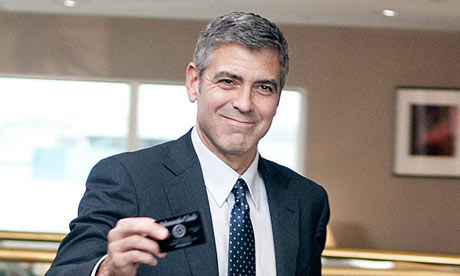
Product placement used to be simple: just get your superspy burning after the dolly-bird in the appropriate shag-mobile, and watch Aston Martin sales fly. But now advertisers have to be prepared to expose their brands to negative associations in order to grab attention. When George Clooney, playing a corporate troubleshooter in his latest film Up in the Air, wheels his Travelpro® luggage past a barrage of brands – Hilton, Hertz and American Airlines – it looks like traditional placement. But the longer he lingers in antiseptic airport lounges and foyers, the more Up in the Air starts to feel like an attack on the brands it’s supposed to be pushing. “We’re two people who are turned on by elite status,” notes Clooney’s hotel hookup after they’ve been comparing loyalty cards. The comment hangs heavily.
- Up in the Air
- Production year: 2009
- Country: USA
- Cert (UK): 15
- Runtime: 109 mins
- Directors: Jason Reitman
- Cast: Anna Kendrick, Danny McBride, George Clooney, Jason Bateman, Melanie Lynskey, Vera Farmiga
There’s definitely a subtle change afoot in the movies, as the idea of product placement in negative contexts gains traction. It’s a move on from the lampooning of old-school hard sell in movies by the likes of Wayne’s World. Adidas’s decision to provide the house attire for the dorkish narcissists at Hardbodies gym in Burn After Reading was interesting, to say the least. TV production company Celador okayed the torture scenes in Slumdog Millionaire, provided it was the host, not the company’s show, Who Wants to Be a Millionaire? itself, who brought the pain. It’s an attempt by advertisers to be more sophisticated than obtrusive catastrophes such as Cast Away – which “starred” FedEx.
Director Jason Reitman felt Up in the Air, as with most contemporary stories, wouldn’t work at all without actual brand names. He replaced the fictional logos in Walter Kirn’s original novel with real-world counterparts, and says that neither Hilton or American Airlines contributed any financing, just advice. He didn’t even go through the official channels at Hilton to arrange the placement; he walked up to the manager on the desk at Hilton St Louis, a regular haunt of his, with the idea. Andrew Flack, vice-president of global marketing at Hilton, says invisibility was the watchword: “We didn’t want to be part of the story, we just wanted to be the backdrop.”
But bumpy moments for the brands are unavoidable as they are woven so deeply into the fabric of movies, especially if the protagonist is as ambiguous as Clooney’s unsentimental downsizer. A scene in which he finally crosses his long hoped-for 10m air miles could have been pure on-screen pyrotechnics for American Airlines, but is actually a rather sombre moment in the movie. Billy Sanez, director of corporate communications at American Airlines, is relaxed about it: “Unfortunately at the time [Clooney’s character] was waiting for something great for him, something really bad happens. These things happen in life, and I didn’t have a problem to be associated with that reality. We’re part of people’s lives. It’s not always cheery fun and games.” PR consultant Mark Borkowski thinks it’s ultimately a risk worth taking: “It says more about the strength of a brand. They’re willing to allow that negativity to give it a greater depth of personality. It takes an enlightened marketeer, and there aren’t enough of them.”
Keen to stretch the perimeter of their ”personality”, these progressive companies have spawned some marketing-speak: they are “challenger brands”. Apple is at the vanguard, and there is hardly a film these days with a computer in it that doesn’t have the glowing fruit prominently displayed. Few companies would feel confident enough to run with Brüno’s joke about swapping an iPod (Red U2 edition) for a black baby.
Of course the Brüno gag is a clever one, both positioning Apple in the cool, edgy logo elite, and allowing us to feel superior. It’s reminiscent of the Ikea catalogue scene in Ed Norton’s apartment in Fight Club: a paid-for anti-consumerist manifesto in the film that spearheaded the trend for inverse product placement. Both sides in the product placement deal are treading the fine line now necessary, as Borkowski puts it, “in an age where the consumer is given the view that it is in control of the game”.
No comments:
Post a Comment
Feel free to comment on this post...